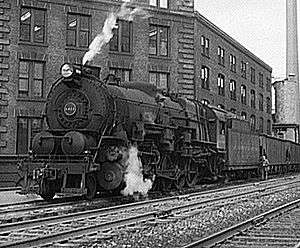Pennsylvania Railroad class I1s
The Pennsylvania Railroad's class I1s steam locomotives were the largest class of 2-10-0 "Decapods" in the United States, with 598 built 1916–1923 (Altoona: 123, Baldwin: 475). They were the dominant freight locomotive on the system until World War II, and they remained in service until the end of PRR steam in 1957. Nicknames for the type included Decs and Hippos, the latter due to the large boiler. Unlike smaller 2-10-0s that preceded them, the I1s design was huge, taking advantage of the PRR's heavy trackage and high allowed axle load, with a wide, free-steaming boiler. Large cylinders enabled the I1s to apply that power to the rails. Their power was undeniable, but they were very popular with the crews, for they were easy riding at all but low speeds. One author described them as "the holy terror of the PRR". The large boiler limited the size of the driving wheels, which made it impossible to mount counterweights large enough to balance the piston thrusts.
| Pennsylvania Railroad I1s | |||||||||||||||||||||||
|---|---|---|---|---|---|---|---|---|---|---|---|---|---|---|---|---|---|---|---|---|---|---|---|
 | |||||||||||||||||||||||
| |||||||||||||||||||||||
| |||||||||||||||||||||||
| |||||||||||||||||||||||
| |||||||||||||||||||||||
Subclass I1sa increased maximum steam cut-off to admit steam for 78% of the piston stroke (rather than the original 50%), boosting low speed tractive effort from 90,000 to 96,000 pounds-force (400 to 430 kN). There was no obvious external difference except for a revised builders' plate (and of course the revised combination lever). I1s locomotives were converted to I1sa during major overhaul; eventually 489 were converted while 109 remained as built. Some of the I1sa locomotives had the feedwater heater moved from the side of the boiler to underneath the cab. The preserved I1sa number 4483, is one of these very few locomotives with the feedwater heater moved from the side of the boiler to underneath the cab. There were only 85 I1sa locomotives with this change was only on the locomotives that ran on the Elmira Branch from numbers 4335 to 4634. This makes this 4483 very valuable.
In 1923 PRR put engine 4358 on the Altoona test plant. The tests below were all stoker fired.
- In two hours at 7.12 miles per hour (11.46 km/h) it consumed 8,129 pounds (3,687 kg) of coal (13,398 BTU/lb or 5,760 kJ/kg) and averaged 71,993 pounds (32,655 kg) of tractive effort at the driver rims, corresponding to 6.4% thermal efficiency.
- In one hour at 14.24 miles per hour (22.92 km/h) it consumed 6,809 pounds (3,089 kg) of coal (12,682 BTU/lb or 5,452 kJ/kg) and averaged 63,263 pounds (28,696 kg) tractive effort, or 7.1% efficiency.
- At 22.02 miles per hour (35.44 km/h) (40% cutoff, so not a maximum effort) it consumed 7,000 lb/h (3,200 kg/h) of 13,039 BTU/lb (5,606 kJ/kg) coal and averaged 43,515 pounds (19,738 kg) TE, for 7.1% efficiency.
- At 21.36 miles per hour (34.38 km/h) at 50% cutoff it consumed 5,230 pounds (2,370 kg) of 13,372 BTU/lb (5,749 kJ/kg) coal in 30 minutes averaging 51,409 pounds (23,319 kg) TE, for an efficiency of just under 5.4%.
Preservation
Of the nearly 600 class I1 locomotives built for the Pennsy, a sole example, #4483, survived the scrapper's torch. The locomotive was retired in August of 1957. A strange fact about 4483 is that it's firebox and four of its driving wheels of the H6sb 2843. 2843 which was built in 1905, got into an accident with an other locomotive of its class. The wreckage was reviewed and was considered inoperable and the firebox and driving wheels were fitted onto 4483 in 1917. Following then Chief of Motive Power Hal T. Cover's instructions, the railroad moved the engine to its roundhouse in Northumberland, PA, along with several other retired steam locomotives labeled for preservation. There the engine sat until 1963, when the PRR sold it to the Westinghouse Air Brake Company (WABCO) and moved the engine to Wilmerding, PA. WABCO had originally sought a railroad-themed display for its headquarters to commemorate its heritage of supplying air brakes to America's railroads. #4483 saw little maintenance during its life as a display piece for the company and its condition deteriorated significantly, although the boiler's asbestos cladding was removed.[1]
By 1982, the company had grown tired of the locomotive on its front lawn. The Western New York Railway Historical Society acquired #4483 and moved the engine to Hamburg, NY, where it resides today, receiving occasional maintenance. Currently, the organization hopes to move the locomotive to the Heritage Discovery Center in Buffalo, NY, where the engine will sit on public display protected from the elements.[1]
Gallery
 PRR I1s #4300 in its Baldwin Locomotive Works builders' photo, taken in 1922.
PRR I1s #4300 in its Baldwin Locomotive Works builders' photo, taken in 1922..jpg) PRR I1sa #4483 currently being cosmetically restored at Hamburg, New York.
PRR I1sa #4483 currently being cosmetically restored at Hamburg, New York..jpg) Tender view of 4483
Tender view of 4483
References
- "PRR #4483". Western New York Railway Historical Society. February 7, 2017. Archived from the original on October 17, 2018. Retrieved September 15, 2019.
External links
- Photo Gallery and Further History of #4483
- Audio of I1sa starting a heavy coal train, 1949
- Info and Photos on modeling an N Scale PRR I1s
- Diagram
| Wikimedia Commons has media related to Pennsylvania Railroad I1s. |